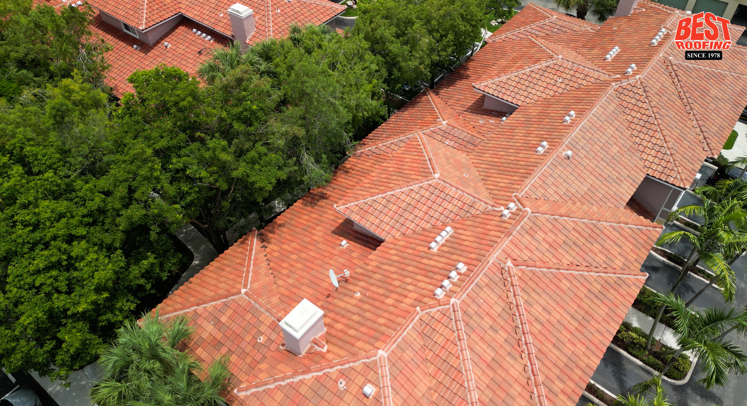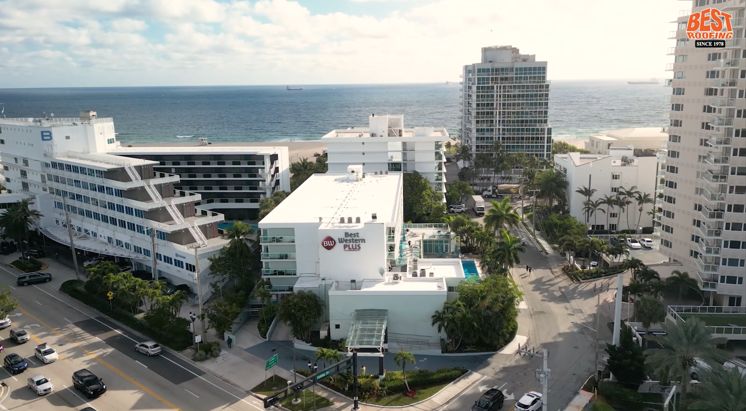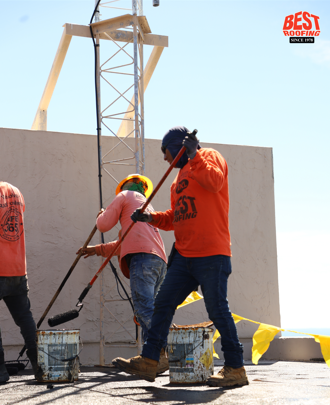If you manage a commercial building, community association, or multi-family property in Florida, understanding tile roof replacement cost helps you plan capital budgets, avoid surprises, and protect your investment through proper inspection, specification, and code compliance.. This guide breaks down realistic cost ranges, what drives pricing, and how tile roof life expectancy impacts long-term value—plus how to get a precise estimate your board can approve confidently.
Average Tile Roof Replacement Cost in Florida
Tile roof replacement costs vary significantly and must be confirmed through a documented roof audit, wind design, and code review. Project budgets depend heavily on tile type, underlayment requirements, access, and structural conditions.
Costs for small and large projects vary and should not be generalized without verified field conditions.
Commercial projects trend higher due to access challenges, safety requirements, and tenant coordination. Use any early cost numbers as planning references only—not guaranteed pricing.
Tile roof replacement budgets in Florida can range widely depending on materials, access, and hurricane zone requirements. Always confirm with a detailed roof audit, wind design, and permit review.
Key Factors That Influence Tile Roof Cost
1. Roof Size & Complexity
Larger or multi-level roofs require more material, staging, and labor. Complex designs with hips, valleys, or multiple elevations add time and precision work. Limited access (common in gated or occupied communities) also increases setup and safety costs.
Projects in coastal wind zones may require enhanced fastening patterns or structural verification under FBC Chapter 15.
2. Tile Type & Profile
Tile selection plays a major role in total cost:
- Concrete tile: Common and cost-effective; performance depends primarily on underlayment and fastening compliance.
- Clay or terracotta tile: Durable and color-stable; longevity assumes periodic inspection and timely underlayment replacement.
- Slate or specialty tiles: Premium look and weight—often require structural reinforcement.
Interlocking or flat tiles install faster and may reduce labor costs compared to barrel or mission styles.
3. Labor & Market Conditions
Florida’s roofing market is busy year-round, and labor rates vary by region. Projects requiring weekend, nighttime, or tenant-coordinated work usually carry higher premiums.
4. Underlayment & Deck Condition
Your underlayment, not the tile, is what keeps water out. If it’s aged or damaged, replacement is mandatory during a reroof. Wood decking issues, such as rot or nail-pull, also add cost. High-temperature, self-adhered underlayments rated for tile applications provide improved performance in high-heat and hurricane zones when installed over clean, dry decks and terminated per manufacturer details.
5. Roof Pitch & Code Requirements
Steeper slopes, wind-zone fastening patterns, and hurricane code compliance can all increase time and material usage. Wind uplift resistance must meet or exceed FBC and Miami-Dade NOA (if applicable). Verify tile attachment spacing using FRSA/TRI Tile Manual or manufacturer’s uplift tables.
6. Roof Features
Each penetration, skylight, vent, drain, or parapet adds flashing detail and complexity. The more features, the more installation hours.
How Costs Are Calculated

Roofing contractors typically estimate tile roof replacement per square foot or by the “square,” which equals 100 square feet.
Ask your contractor for a line-item proposal showing:
- Tile and underlayment materials
- Flashing and fastening systems
- Tear-off and disposal costs
- Deck repair allowances
- Safety and site logistics
This clarity helps your board validate assumptions and compare bids fairly.
Tile Roof Life Expectancy
Concrete Tile Roof Life Expectancy
Concrete tile roofing can perform for multiple decades when installed over properly maintained underlayment systems. Underlayment typically requires replacement prior to the full service life of the tile. Confirm that bids specify tile uplift compliance (FBC/FRSA–TRI), underlayment type, and flashing metal gauge. Require manufacturer warranty eligibility language if offered.
Clay or Terracotta Tile Roof Life Expectancy
Clay tiles can last around 50 years with proper roof maintenance. They resist fading and handle Florida’s sun and salt air exceptionally well. Service life varies and depends on underlayment renewal and adherence to maintenance schedules.
Why Underlayment Determines Roof Longevity
Tiles protect against UV and impact, but the underlayment is the waterproofing barrier. Installation must meet manufacturer specifications for overlap, fastening, and sealing. Most warranties require documentation of proper attachment and deck condition.
Budgeting for Additional Costs
- Tear-off & disposal: Varies by project; confirm after field evaluation
- Permits & inspections: Costs vary by AHJ
- Deck repairs: Common on older roofs—plan an allowance per sheet of plywood
- Safety & logistics: Cones, barricades, crane lifts, and pedestrian controls for occupied sites
- Optional upgrades: Gutters, fascia/soffit repair, or insulation can be bundled for efficiency
These soft costs are often overlooked but essential to a realistic budget.
When to Repair vs. Replace a Tile Roof
Choose replacement when:
- The roof is beyond two-thirds of its lifespan
- You have widespread underlayment failure or chronic leaks
- You want to standardize tile profiles or colors across multiple buildings
Consider that re-covering over existing tile is generally not permitted under the Florida Building Code; full tear-off is required to inspect deck and replace underlayment.
Choose repair when:
- Damage is localized (a few cracked tiles or one leaking section)
- The underlayment is still within service life
- You need a short-term fix before a larger capital project
Getting an Accurate Estimate for Your Property
- Schedule a Roof Audit
A qualified roofing contractor should measure, photograph, and perform destructive testing only with owner authorization to produce a detailed scope.
- Standardize Specifications
Define tile type, underlayment brand, and fastening methods so bids are comparable. - Request a Line-Item Proposal
Ask for per-square pricing, deck repair allowances, and optional add-ons. - Plan Phasing Around Operations
Coordinate schedules with tenant occupancy, pool hours, or parking access to reduce disruption. - Include Ongoing Maintenance
Schedule semiannual inspections and after-storm reviews. Keep drains, valleys, and flashings clear. Maintain written maintenance logs—required by most manufacturer warranties.
Final Thoughts & Next Steps
Tile roofs offer exceptional lifespan and long-term value, but accurate budgeting depends on the specifics of your property, size, materials, and existing deck condition. Every tile roof replacement must comply with FBC Chapter 15, FRSA/TRI installation standards, and local AHJ requirements for wind, underlayment, and flashing. Work with a licensed contractor experienced in these systems. For a precise, board-ready proposal:
Why Work With Best Roofing
For more than 45 years, Best Roofing has helped Florida property managers, CAMs, and building owners make informed, confident roofing decisions. Our team specializes in complex commercial and multi-family tile roof replacements, with detailed inspection reports, safety compliance, and minimal disruption to tenants.
Book a Tile Roof Audit to receive measurements, photos, and a detailed cost estimate tailored to your Florida property.



